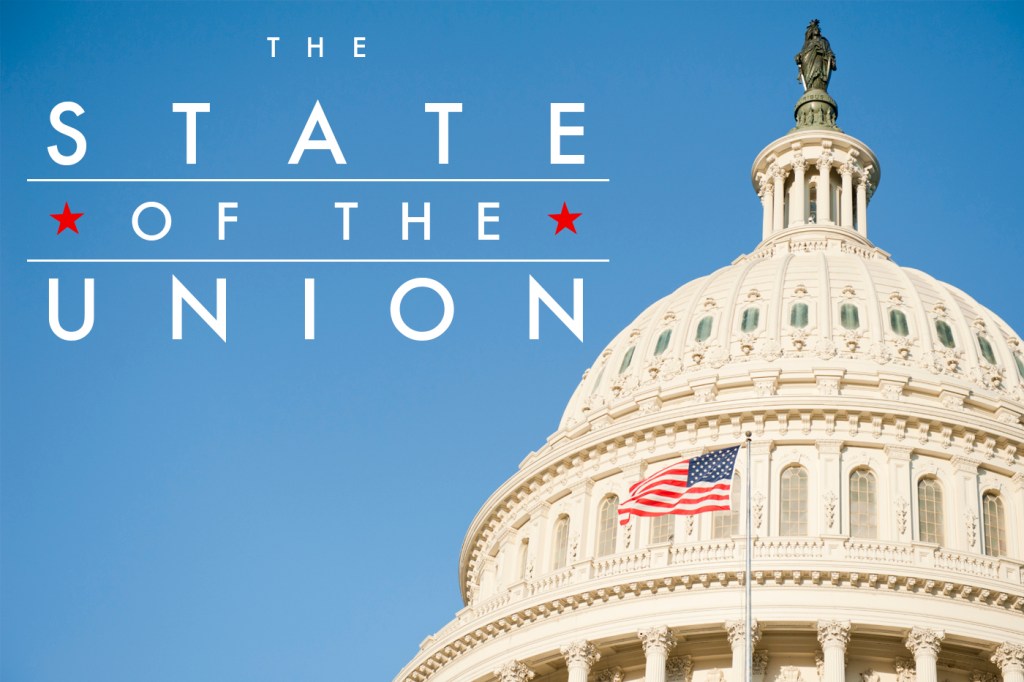Obama’s 2016 State of the Union address, visualized

President Barack Obama on Tuesday evening delivered the final State of the Union address of his two-term presidency. The president’s annual address to Congress—in what some may deem a subtle nod to Franklin D. Roosevelt’s 1941 “Four Freedoms” speech—framed his remarks around “four big questions that we as a country have to answer,” including the economy, technology, security, and America’s political divide.
The president also called for a “new national effort” to cure cancer, and said that Vice President Joe Biden, who last year lost his son to the disease, would be “in charge of Mission Control.”
To provide analysis of the president’s remarks, we turned to Nick Beauchamp, an assistant professor at Northeastern in the Department of Political Science and the NULab for Text, Maps, and Networks. Beauchamp, who specializes in U.S. politics and political methodology, has done extensive research to visualize the rhetorical structures of political speeches.
Here is his commentary:
Shortly before his final State of the Union address, Obama tweeted “I’m treating this last State of the Union just like my first—because I’m still just as hungry.” And indeed, the speech began with the theme of “change”—Obama’s original signature issue—and ended with a peroration calling for citizens of all stations to take political action and overcome partisan divisions. However, there were important differences between this and his inaugural speech, as well as an intriguing development from the first SOTU to the last, and also within this final speech as it moved through its ideas and themes.”
(Beauchamp has developed a new method to automatically visualize that progression of a speech through its themes and topics, via a “Plot Map.”)
Below is a plot map of the 2016 SOTU. Much like the familiar word cloud, the words shown are those that were most common in the speech (not including heavily repeated words like “the” or “America”), where word size is scaled to frequency. But unlike a word cloud, words are positioned such that words that tended to co-occur in the speech are clustered closer together, and colored accordingly. The blue line shows the progression of the speech from beginning (1) to end (4), where the words closest to each numbered segment are those words that were most common in that segment of the speech.
As we can see in the figure, the 2016 SOTU began with the general idea of “change”—Obama’s signature theme—and then moved into “jobs” and the “economy”; pivoted from there to the “world” stage (where, as he pointed out, “ISIL” is a small player); and then concluded with a return to the theme of “change” and the “future,” a future only achievable, he argued, by shifting from “leadership” to the multitude of “voices” described in his closing peroration.
The second figure contextualizes this SOTU with a century of past SOTU addresses, showing how Obama has progressed from his first to his final SOTU. Once again, words are placed automatically in a shared space with documents (SOTU addresses)—red dots for Republican addresses, blue dots for Democratic addresses, and numbered purple dots for Obama’s addresses. As before, the words closest to a SOTU dot are those words that were most common in that speech.
Here, the notable thing is that the vertical dimension automatically captures a partisan division that extends over a century, with the top having more Democratic speeches, and the bottom more Republican; looking at the words, the top tends to be more domestic issues, while the bottom is more international. Along the other axis, left seems to be more policy matters, while the right tends to be grander rhetoric. Obama’s first SOTU speech is strongly Democratic with grand rhetoric, but then his speeches become more Republican-like (down) and policy-oriented (left) in years 2010-12 (purple dots 10-12); and then shift from policy towards grander rhetoric (right) in years 2013-15; and finally he finishes up very much in the center, just as his 2016 SOTU itself finished by emphasizing his old theme of transcending partisanship to make a better country.
Thus the story of Obama’s progression, both within this speech and across his eight SOTU addresses, is more complex than a simple summary or word cloud could describe. In both cases, he returns to the themes he originally laid out, but with an evolution as well: from more concrete policy and economic details, to broader and grander rhetoric about change, diversity, and the future of America in the world. These new visualization techniques allow us to see these developments in an immediate way, and can also be used to study more general rhetorical structures across thousands of political speeches.







